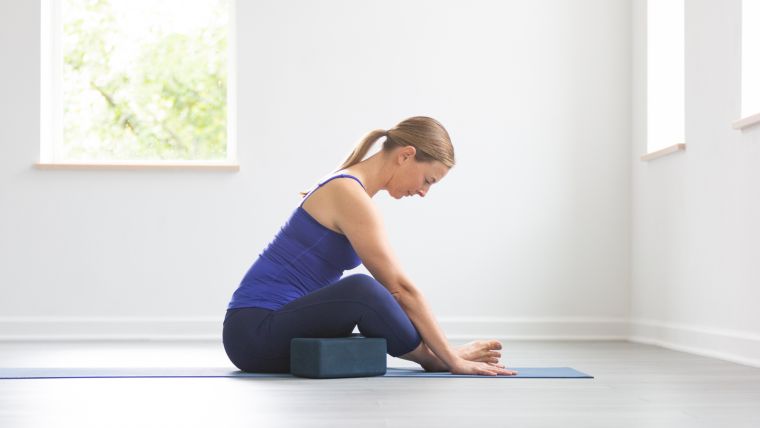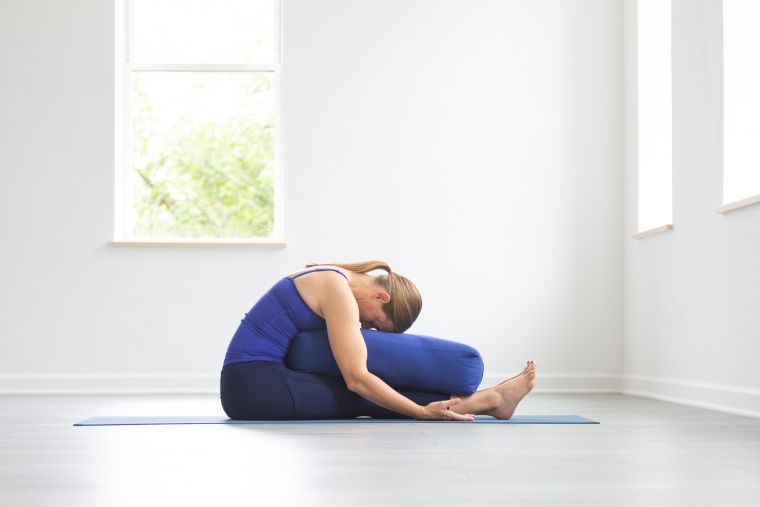Articles, In the Press, Rachel Land, Resources, Yin, Restorative and Meditation, Yoga Medicine® News
Why Flexible People Can Still Benefit from Yin Yoga
Senior Yoga Medicine® teacher, Rachel Land, shares four ways that even the most flexible yogis can benefit from yin yoga.

Yin yoga is commonly equated with passive stretching, which is perhaps why some people see it as an unhelpful practice for more flexible people. If the aim of yin yoga were merely to increase range of motion, I might agree. Fortunately, however, yin has much more to offer than flexibility gains.
There are four other potential effects of yin that even the most supple students can benefit from.
1. Collagen Synthesis
Yin targets the connective tissue, or fascia, that surrounds, encapsulates, connects, and interpenetrates the bones, muscles, organs, nerves, and blood and lymph vessels. Fascia is adaptive, constantly responding to the demands we place on it.
So rather than aiming to stretch fascia, yin poses subject it to subtle but sustained “stress”—including compression and shear, or rotational force, as well as stretch. This seems to stimulate specialized cells within the fascia, called fibroblasts, to lay down additional collagen fibers in the direction of the stress. Collagen fibers give our soft tissue its structure, strength, and capacity to connect the parts of the body into a unified whole.
This adaptive process is not unique to fascia—most of us are familiar with the idea that strength training makes our muscles stronger, or that cardiovascular training makes our heart and lungs more efficient. So for flexible students, instead of making their already supple tissues weaker, yin can actually encourage their fascia to become stronger and more resilient; the key is to set up in yin poses in a way that creates a gentle, sustained sensation rather than a deep stretch.

To do butterfly pose in a way that prioritizes subtle but sustained “stress” over a deep stretch, a flexible student might practice with knees propped with blocks, and hands on the floor with arms straight to support the spine.
2. Hydration
Subtle stress on our fascia has multiple flow-on effects, including temporarily squeezing fluid out of our fascial layers. As discussed above, it also stimulates fibroblasts, resulting in collagen synthesis, and the production of a chemical called hyaluronic acid. Water-loving hyaluronic acid attracts a rush of water molecules from surrounding tissue back into the fascia, initiating a process of rehydration that outlasts yin practice by hours.
Visualize a sponge submerged in water: Squeezing, twisting, and pulling on the sponge drives out residual fluid, creating space for fresh water to fill it up again.
Good hydration is vital to the healthy function of fascia for two key reasons:
• Hydration yields better glide between fascia layers, allowing for free movement and circulation between body surfaces and structures and reducing the potential for irritation and adhesion.
• Water is incredibly resistant to compression, so that when our tissues are well-hydrated they are stronger and more resilient to life’s demands. An easy way to visualize the structural strength of a fluid-filled system is to imagine a plant wilting from lack of water, its stems bowing under the weight of its leaves—but as soon as you water that plant you’ll see it stand tall again.

The gentle compressive forces of a twist can initiate a process of rehydration that outlasts yin practice by hours.
3. The Relaxation Response
Physiologically, yin practices have the capacity to balance our autonomic nervous system (ANS), which governs unconscious or involuntary body processes like heart rate, breathing, pupil dilation, and muscle tension. The ANS has two arms. The sympathetic nervous system (SNS) triggers the fight or flight response, priming us to handle perceived threats with quick and decisive action. The parasympathetic nervous system (PSNS) governs the relaxation response: It is ideally the dominant force during daily life—diverting blood away from the muscles to the digestive, reproductive, and immune system organs.
Few would dispute that modern life is very yang—emphasizing movement and action, and exposing us to constant stimulation. The frantic pace of life today means that the SNS is far more active than our biology intended it to be, and many of us are seeing that imbalance reflected in our physical and mental health.
Yin yoga allows us the time and space to find the nourishing stillness required to downregulate the ANS. When we prop ourselves in yin poses in a way that allows us to truly rest, we might feel our vigilance, heart rate, and blood pressure lower while our immune, digestive, and reproductive functions improve.
Students with large ranges of motion won’t feel stress on their fascia in all positions. But if they simply settle into stillness they can still benefit from the soothing impact on their nervous system.

While a very flexible student may not feel a big stretch in bananasana (a.k.a. supine half moon pose), by resting there in stillness, their nervous system can still benefit greatly.
4. Energy Flow
The same way a road map and a weather map show completely different views of the same terrain, the Western view of the physical body comfortably coexists with the Eastern model of an energy body. The energy body referenced in yin comes from Traditional Chinese Medicine (TCM) and is composed of life force, or qi, which is thought to flow through specific channels called meridians.
According to TCM principles, the physical stress created by yin poses also stimulates the flow of qi through the meridians. Poses that compress the abdomen could be viewed as supporting healthy digestion by compressing our abdominal organs and by nourishing the stomach meridian. Poses that lengthen the back seam of the body not only gently stress the thoracolumbar fascia and hamstrings but also support the soothing and introspective qualities of the bladder meridian.
We in the Western world may not be as familiar with the energy body as we are with the physical body. However, we don’t have to be able to see or understand electricity in order to grasp its effects when we switch on a light. Likewise, we don’t have to fully understand Traditional Chinese Medicine to know that we feel different after yin yoga; even the most flexible students can still benefit hugely from its capacity to nurture good flow of qi.

Caterpillar pose, propped, is a great way for flexible students to feel nurtured and turn inward in practice. According to Traditional Chinese Medicine, this pose supports the introspective qualities of the bladder meridian.The key to reaping these broader benefits, especially for students with extensive range of motion, is to follow three guiding principles in each pose:
• REDUCE YOUR DEPTH. Rather than coming to your usual endpoint, approach each pose slowly enough to stop where you first feel sensation. If you’re anything like me, that will be an enormous reduction in the depth of the pose—meaning that you’ll stay closer to 50 percent of your full range of motion. Unlike in restorative yoga, the aim is to feel some sensation, but the key word is: some.
• FIND SOMEWHERE YOU CAN RELAX. Once you’ve found your new version of the pose, take time to set yourself up so that your muscles can relax as completely as possible. That may involve using props to fill the gaps between your body and the floor, or leaning into the support of your arms or a wall. It could even involve an alternate version of a pose, like lying on the floor with your legs up a wall instead of doing a seated forward fold.
• STAY IN STILLNESS. Fascia, the target tissue of yin practice, is highly adaptive— constantly responding to the demands we place on it. Its response, however, is slow and gradual. To target our slow-reacting fascia we need to stay in the same subtle, relaxed shape for at least a couple of minutes.
There’s no doubt that yin yoga can help those who would like a little more mobility. But it also has the potential to maintain well-hydrated, elastic, and resilient soft tissue, rebalance the nervous system from the constant stimulation of modern life, and regulate the flow of energy. Even the most flexible students can realize these benefits by practicing yin with a subtle approach—not going as deep, finding a shape they can relax into, then staying patiently still. The key, as with any yoga practice, is not in what we do but how we do it.
Photography: Andrea Killam












